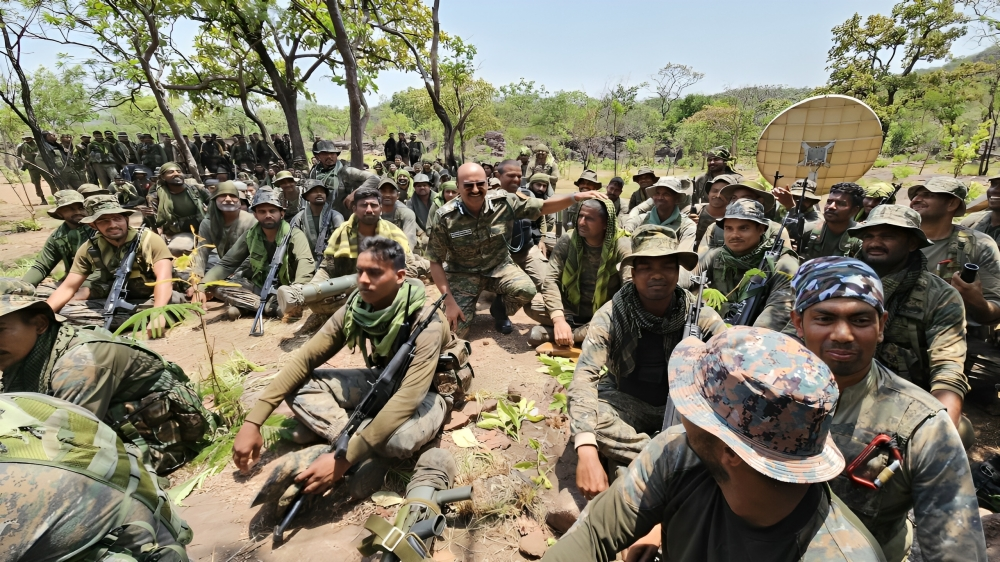In a defining moment in India’s battle against Left-Wing Extremism (LWE), Central Reserve Police Force (CRPF) Director General Shri G.P. Singh was seen leading from the front in the ongoing Operation BlackForest, deep in the rugged terrain of the Korregutta Hills. This operation targets entrenched Maoist strongholds along the Chhattisgarh-Telangana border, signaling a forceful and coordinated push to neutralize Naxalite influence in one of India’s most critical insurgency-affected zones.
Photographs from the field depict DG Singh standing among a formation of CRPF personnel clad in combat gear, delivering a strategic briefing amidst dense forest cover. The image of officers and jawans gathered around their chief underscores a leadership style that favors frontline engagement over remote supervision—a powerful reflection of CRPF’s operational philosophy and morale.
Launched in early May, Operation BlackForest has already achieved notable success. In a major tactical innovation, the CRPF employed cave interventions to dismantle Maoist infrastructure hidden in the labyrinthine Karregutalu Hills. Intelligence reports confirmed that over 250 caves were being used by Maoist cadres as hideouts, weapons workshops, and storage hubs for explosives, food, and communication gear. During the operation, CRPF units recovered 818 barrel grenade launcher shells and 450 improvised explosive devices—an alarming cache that underscores the magnitude of the threat in the region.
The presence of the CRPF’s top brass in such a high-risk zone sends a strong message of resolve. DG Singh’s visit is not merely symbolic; it is part of a comprehensive strategy aligning with Union Home Minister Amit Shah’s target of eradicating Naxalism by March 31, 2026. This goal was publicly declared during the CRPF’s 86th Raising Day in Neemuch on April 17, where Shah credited the force for dismantling major Maoist networks and pledged continued support for their mission.
Bijapur, a district long plagued by LWE activity, is one of the focal points of this renewed offensive. DG Singh had previously chaired a strategic review in the area on February 1, 2025, where he outlined the need for synchronized operations with Chhattisgarh Police, enhanced intelligence capabilities, and new tactical doctrines adapted to forest warfare. The emphasis on inter-agency collaboration and real-time reconnaissance reflects the evolving nature of CRPF’s counter-insurgency efforts.
Historically, the CRPF has played a pivotal role in combating insurgency across the Red Corridor. From neutralizing senior Maoist leader Kishanji in 2011 to launching operations in Saranda, Maad, and Burha Pahad, the force has steadily pushed back extremist elements. In recent years, the focus has shifted towards establishing Forward Operating Bases (FOBs) in dense forest regions like Chhattisgarh to support long-duration operations, reduce reaction times, and expand the reach of state authority.
Operation BlackForest exemplifies this doctrine. By penetrating deep into previously inaccessible Maoist zones, the CRPF is not only dismantling logistical hubs but also reclaiming psychological ground. The operation’s success thus far serves as a morale booster to troops and a warning to Maoist factions that their safe havens are no longer secure.
As the countdown to the 2026 deadline continues, DG Singh’s active participation in ground operations demonstrates that leadership at the highest levels remains committed to achieving a Naxal-free India. The momentum generated by Operation BlackForest could prove pivotal in shifting the security paradigm in the heartland of LWE-affected India. With continued strategic clarity and operational rigor, the CRPF is poised to fulfill its mission of securing peace, development, and democratic governance in the region.













